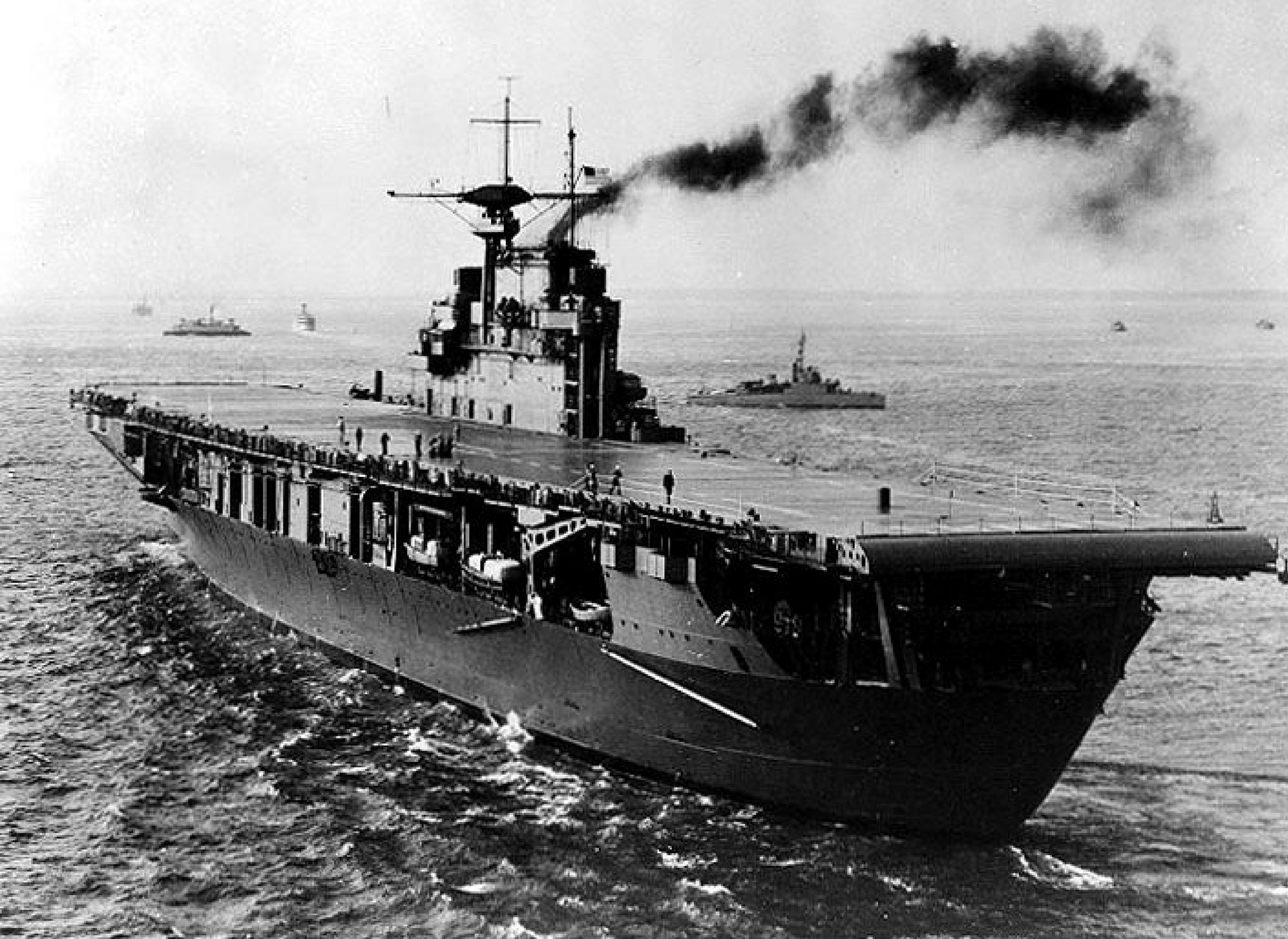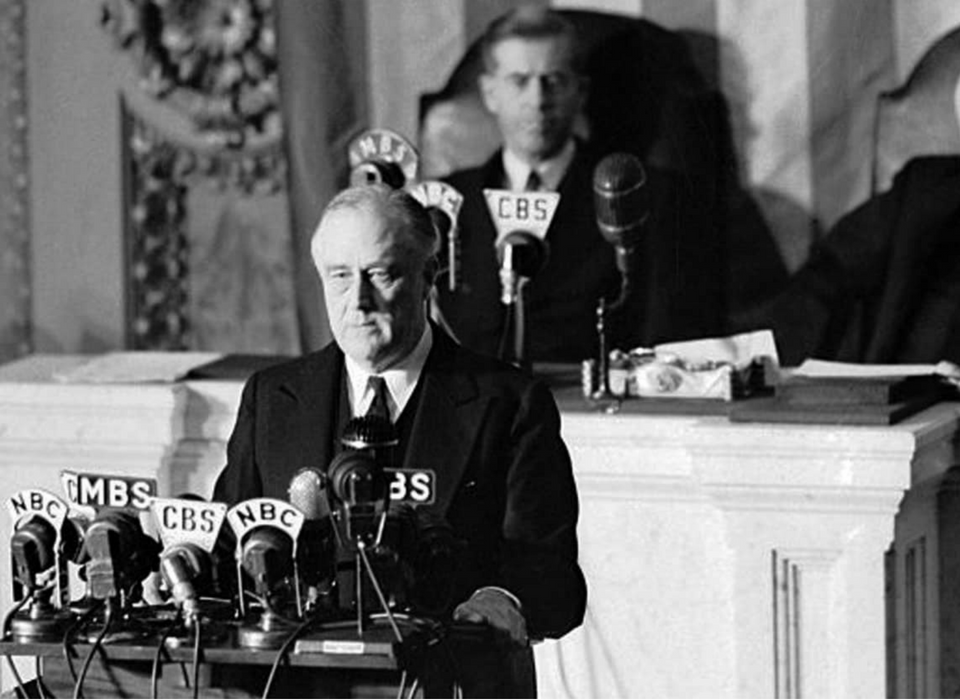This post is part of a new series on the enduring lessons of leadership in World War II. Our museum is proud to offer presentations and facilitated seminars for professionals facing today’s leadership challenges. We draw on our knowledge of the war to offer practical, applicable, and inspiring ways to lead, based on the proven examples of leaders who faced the greatest war in human history with skill and success. This first post looks at how visionary, courageous, and innovative leaders restored the pride and morale of a nation in crisis.
On December 7, 1941, disaster struck the United States when the Empire of Japan crippled the American fleet at Pearl Harbor. Nearly 2,400 Americans died, three precious battleships, 18 other ships, and 188 aircraft were lost in the attacks. Overnight, America was at war and in a national state of shock. Americans were angry, dispirited, or just plain confused. After the initial surprise, Americans looked to their leaders to respond to the challenge. In today’s leadership parlance, Pearl Harbor thrust the United States into a Volatile, Uncertain, Complex, and Ambiguous (VUCA) environment.
At the moment of crisis, visionary leadership is decisive and drives outcomes on the strategic level. American leaders responded to these conditions using several linked leadership attributes: vision, empowerment, determination, and courage in accepting necessary but high levels of risk. The contemporary workplace requires similar leadership skills, and much can be learned from the examples of WWII leaders.
Waking up to war on December 7, 1941, Americans faced all of the VUCA conditions in spades. For any nation (or organization) to find its way through a crisis, a senior leader must develop and articulate a vision to inspire a united and consistent response. President Franklin Delano Roosevelt’s response to Pearl Harbor provides a great case study in crisis leadership. FDR’s legendary communication skills helped focus American resolve, starting with his powerful address to Congress on December 8, where he stated plainly that, “No matter how long it may take us to overcome this premeditated invasion, the American people in their righteous might will win through to absolute victory.” At a time when many Americans found themselves angry, confused, or just anxious, President Roosevelt exuded confidence and told the nation on December 9 that, “the United States can accept no result save victory, final and complete. Not only must the shame of Japanese treachery be wiped out, but the sources of international brutality, wherever they exist, must be absolutely and finally broken.” The president set out a clear and powerful vision, but it fell to other leaders to bring that vision into being.
While vision is one key aspect of leading a nation or an organization through crisis, Innovation is another—a powerful vision requires equally big ideas to bring it to life. Innovation and bold execution are the twin pistons that drive the engine of vision. Vision lays out a motivational blueprint for others to act, be empowered, and remain committed even at difficult times. Innovation is the means by which solutions are created—innovators make visions into reality.
Navy Captain Francis “Frog” Low was the innovator who brought forward an idea to restore American confidence and to deliver the results the nation was looking for in the wake of the Japanese attack. As with many great innovators, Low saw an opportunity by combining already existing concepts—he was the first to imagine the possibility of flying bombers off the deck of an aircraft carrier. Low believed America could strike back at Japan if it could get a carrier close to the Japanese Home Islands and launch bombers off its deck. At the time the idea seemed outlandish—but Low’s careful thinking and detailed arguments convinced Admiral Ernest King, then Commander in Chief, United States Fleet. With King’s approval, America now had a response to the attack on Pearl Harbor. While Low embodied the importance of innovative solutions in times of crisis, Admiral King’s leadership represented the other end of successful innovation—understanding. King empowered his subordinates to craft solutions and then listened actively to the solution Low offered. As all great leaders do, Admiral King was seeking opportunities in crisis, a key way of leading through the VUCA environment. With a solution now endorsed, it fell to yet another WWII leader to deliver results.

USS Hornet, CV-8, the carrier that launched the Doolittle Raid. Image:
Already a famous aviator with a number of records to his name, Major Jimmy Doolittle was working to improve American aviation production when the war broke out. Doolittle was a man of action and courage, so somewhat predictably, he requested an immediate transfer to an operational air unit the day of Pearl Harbor. This storied courage represents a third and perhaps most important characteristic of successful crisis leadership—unflinching courage and determination. For these qualities, and his more than 7,000 hours of flight time, the newly promoted Lieutenant Colonel Doolittle was given command of the mission Captain Low had developed and Admiral King had approved. He would lead the counter-strike against Japan that bears his name—the Doolittle Raid.
This ambitious attack required rapid advances in technology to enable the B-25 Mitchell bomber to extend its range to 2,400 miles from the standard 1,300 miles for the bombers to be able to lift off the Hornet and reach Japan. This aspect was one of the defining moments in the success of the mission—Doolittle understood and accepted a very high rate of risk as necessary to achieve the overall American aims. He well knew that his return to America was unlikely at best, yet chose and even fought to lead the mission personally. This decision typified his courage as a leader, and that courage drove the success of this seemingly impossible mission. For any organization to survive and even to thrive in times of crisis, there needs to be this same kind of determined and courageous leadership, willing to accept risk and pursue innovative solutions to complex problems. Fortunately for America, Doolittle was just that kind of leader—he exuded courage and confidence. This was nowhere more apparent than when he landed in Columbia, South Carolina in February 1942 to meet the men of the 17th Bombardment Group. Doolittle assembled the squadron leaders and asked them to volunteer for a dangerous mission, one that would require them to get their B-25s in the air with only 500 feet of runway to work with. Doolittle’s reputation as a leader preceded him: he got his volunteers.
After intense training at Eglin Field in Florida to learn how to launch the bombers from a carrier deck, 16 Bombers crewed by 5 men each rested on the deck of the Hornet on 18 April, 1942. After discovery by Japanese ships, the decision was made to launch the aircraft earlier than scheduled. All sixteen crews reached their targets and dropped their bombs on Japan—after months of planning and many great technical innovations, the raid was a success. However, the Doolittle’s raiders had to find their way on to China, and then hope to find allies on the ground in a country full of Japanese occupying forces.
In the wake of the raid, Lt. Col. Doolittle and his team continued to display the same courage that allowed them to attempt a raid that defied the odds. Eleven of the sixteen plane crews had to bail out of their aircraft in total darkness once their fuel was exhausted. Some were captured by the Japanese and three were executed not long after. The remaining raiders recuperated in China, after local people chose to assist them at great personal risk.. Both their allies on the ground in China and the raiders themselves embodied the courage necessary to endure and even find opportunity in crisis. All 80 raiders received the Distinguished Flying Cross for the Doolittle Raid.
The raid had an impact far greater than its small size might indicate. It had so incensed the Japanese military that Japan diverted resources to China to seek out the surviving raiders, and killed some 250,000 Chinese people in retaliation. The raid also created the first divide between Japanese military and political leaders. The fact that the United States had struck back at Japan caused Japanese civilians to call for a more robust of the home islands. Perhaps most importantly, the raid convinced Japan’s military leaders to expedite their attack on Midway Island—this decision contributed to Japanese defeat at Midway, a major turning point in the Pacific War. For America, the raid was critical to national morale at a critical time.
Success in the Doolittle Raid was the direct result of key leaders addressing the VUCA environment of December 1941 with vision, courage, innovation, and drive. In the immediate wake of Pearl Harbor, the President defined a vision that inspired the nation to strike back at Japan, to begin the long, but necessary path to victory. Other American Leaders, Captain Francis Low and Lieutenant Colonel Jimmy Doolittle, fused the spirit of innovation and raw courage to deliver a powerful response to the Japanese attack. They found the opportunity in the moment of crisis, and in doing so reinvigorated the confidence of a shaken nation.
Learn more about the raid and the legacy of the raiders here. Learn more about the Institute for the Study of War and Democracy here. For more information about Leadership Programs at The National WWII Museum, contact us at ISWD@nationalww2museum.org.
Cite this article:
MLA Citation:
APA Citation:
Chicago Style Citation:






![Max Fuchs, New York City cantor, sings as Rabbi Sydney [sic] Lefkowitz, Richmond, VA, conducts the first Jewish services from Germany.](/sites/default/files/styles/max_650x650/public/2025-10/image1.jpg)

